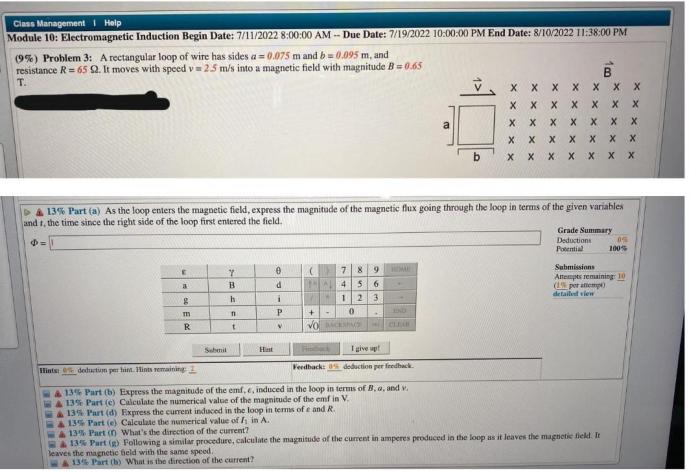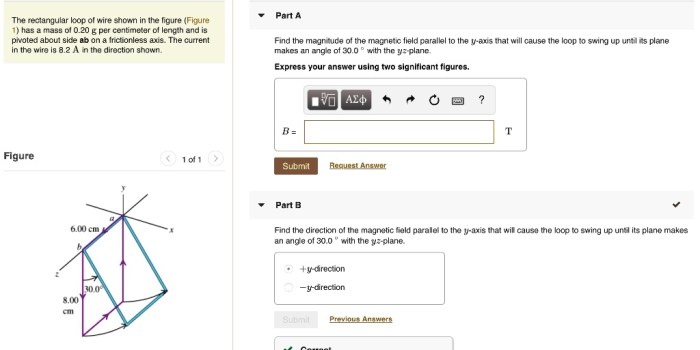A rectangular loop of wire with sides 0.20 and 0.35 presents a captivating subject for scientific inquiry. This loop, characterized by its unique geometric properties, offers valuable insights into the realm of magnetism. Its practical applications span diverse fields, making it a subject of both theoretical and practical significance.
Delving into the dimensions of the loop, we uncover its length and width, which play a crucial role in determining its perimeter and area. These geometric parameters, in turn, influence the magnetic field generated within the loop and its inductance.
The Biot-Savart law provides a mathematical framework for calculating the magnetic field, considering factors such as current, distance, and loop shape.
Dimensions of the Rectangular Loop: A Rectangular Loop Of Wire With Sides 0.20 And 0.35

The rectangular loop of wire has dimensions of 0.20 meters by 0.35 meters. These dimensions determine the perimeter and area of the loop, which are important factors in determining its magnetic properties.
Geometric Properties
The perimeter of the rectangular loop is given by:
P = 2(length + width)
where length = 0.20 meters and width = 0.35 meters.
P = 2(0.20 meters + 0.35 meters) = 1.10 meters
The area enclosed by the rectangular loop is given by:
A = length x width
A = 0.20 meters x 0.35 meters = 0.07 square meters
The perimeter and area of the loop are important factors in determining its magnetic field and inductance.
Magnetic Field Inside the Loop
The magnetic field inside the rectangular loop can be calculated using the Biot-Savart law:
B = μ0/4π ∫(Idl x r)/r^3
where μ0 is the permeability of free space, I is the current flowing through the loop, dl is a vector element of the loop, and r is the vector from the current element to the point where the magnetic field is being calculated.
For a rectangular loop, the magnetic field at the center of the loop is given by:
B = μ0I/4π(a + b)
where a and b are the lengths of the sides of the loop.
The strength and direction of the magnetic field depend on the current flowing through the loop, the dimensions of the loop, and the distance from the center of the loop.
Inductance of the Loop
The inductance of a rectangular loop is a measure of its ability to store magnetic energy. It is given by:
L = μ0N^2A/l
where μ0 is the permeability of free space, N is the number of turns in the loop, A is the area enclosed by the loop, and l is the length of the loop.
For a rectangular loop with a single turn, the inductance is given by:
L = μ0A/l
The inductance of a rectangular loop depends on the dimensions of the loop and the material used to make the loop.
Applications of the Rectangular Loop, A rectangular loop of wire with sides 0.20 and 0.35
Rectangular loops of wire are used in a variety of applications, including:
- Electromagnets: Rectangular loops of wire are used to create electromagnets, which are devices that use electricity to generate a magnetic field.
- Inductors: Rectangular loops of wire are used to create inductors, which are devices that store magnetic energy.
- Transformers: Rectangular loops of wire are used to create transformers, which are devices that transfer electrical energy from one circuit to another.
The specific properties of rectangular loops of wire that make them suitable for these applications include their ability to generate a strong magnetic field, their ability to store magnetic energy, and their ability to transfer electrical energy.
Key Questions Answered
What is the perimeter of a rectangular loop with sides 0.20 and 0.35?
The perimeter is 1.10 meters.
How is the magnetic field inside the loop calculated?
The magnetic field is calculated using the Biot-Savart law, which considers current, distance, and loop shape.
What factors affect the inductance of the loop?
Factors affecting inductance include the number of turns, loop shape, and the presence of magnetic materials.


